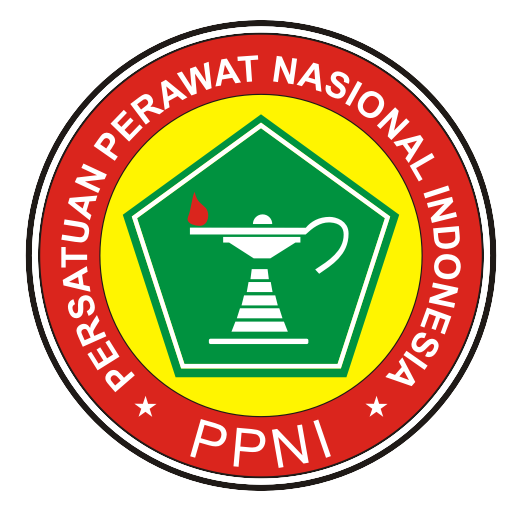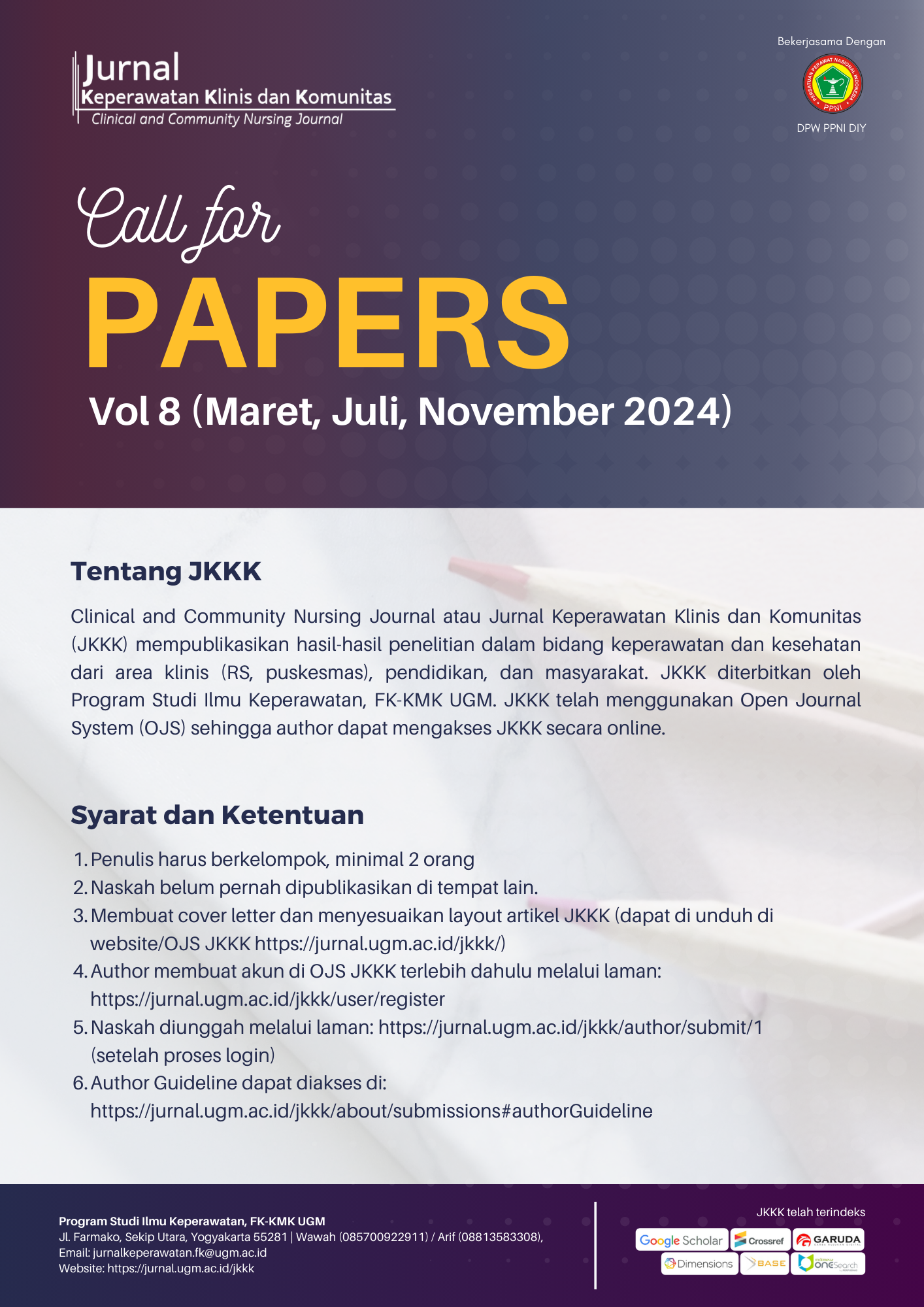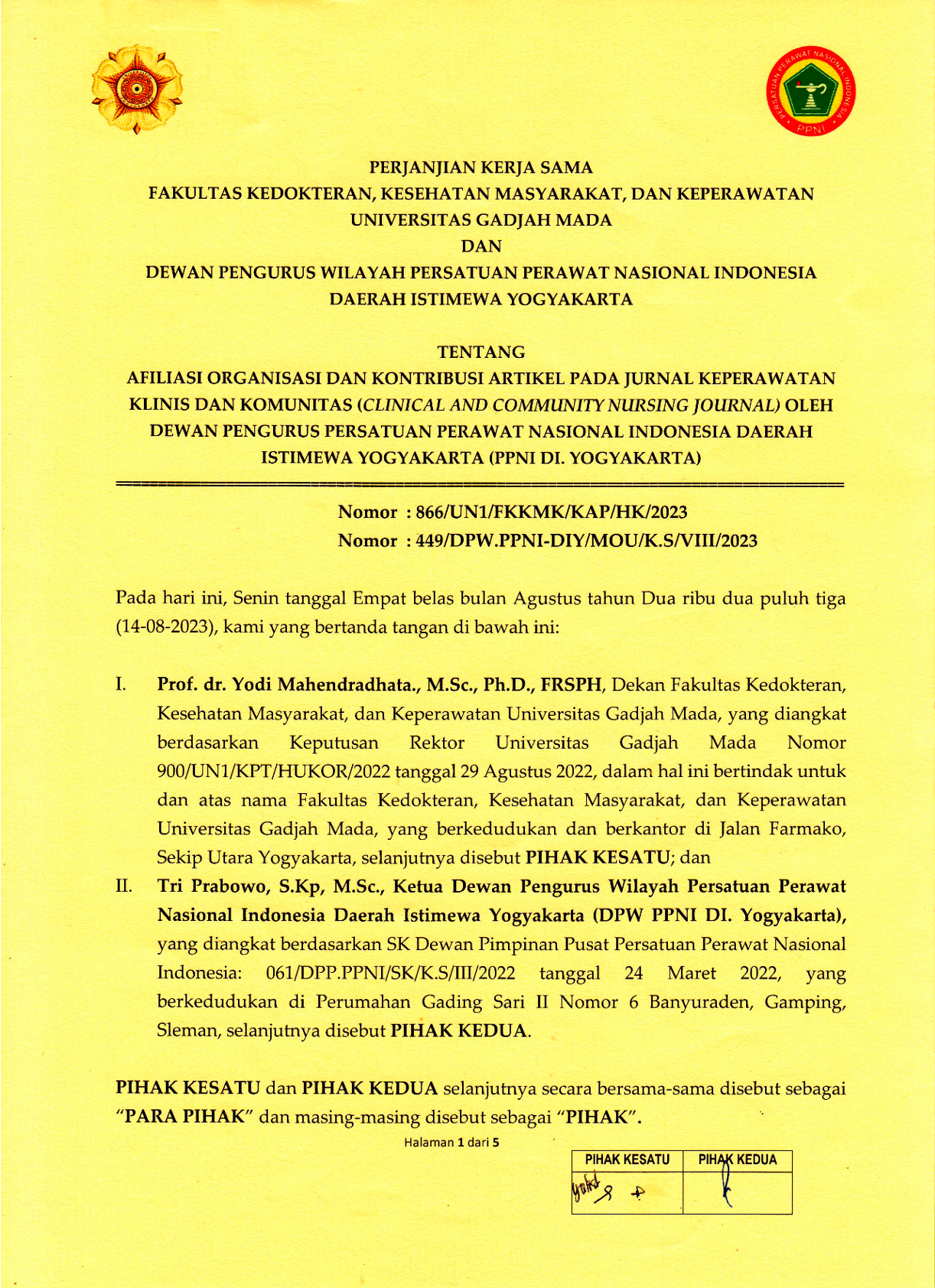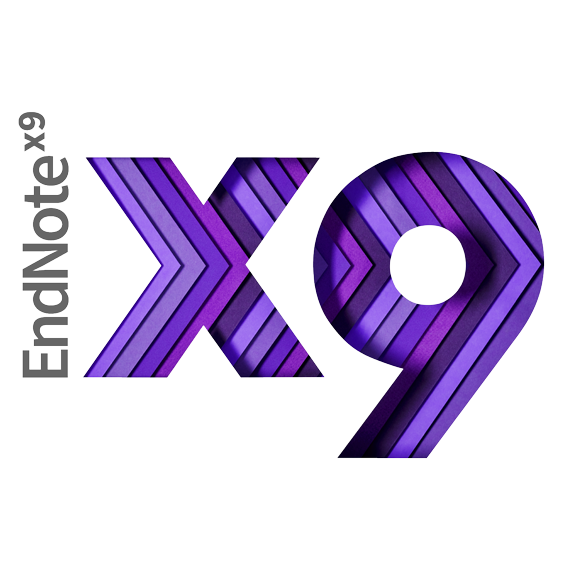Efektivitas Pemberian Pendidikan Kesehatan Terstruktur tentang Penggunaan Teknik Non Farmakologi untuk Mengurangi Nyeri Kanker
Haryani Haryani(1*), Melyza Perdana(2), Septa Adhi Hermawan(3), Malina Luthfiana(4)
(1) Departemen Keperawatan Medikal Bedah, Fakultas Kedokteran, Kesehatan Masyarakat, dan Keperawatan, Universitas Gadjah Mada, Yogyakarta
(2) Departemen Keperawatan Medikal Bedah, Fakultas Kedokteran, Kesehatan Masyarakat, dan Keperawatan, Universitas Gadjah Mada, Yogyakarta
(3) Program Studi Ilmu Keperawatan, Fakultas Kedokteran, Kesehatan Masyarakat dan Keperawatan, Universitas Gadjah Mada, Yogyakarta
(4) Program Studi Ilmu Keperawatan, Fakultas Kedokteran, Kesehatan Masyarakat dan Keperawatan, Universitas Gadjah Mada, Yogyakarta
(*) Corresponding Author
Abstract
Background: Pain is the most common symptoms suffered by cancer patients that can affect their daily activity and quality of life. Non pharmacological intervention to decrease pain often ignored.
Objective: To determine the effectivity of structured health education of non pharmacological intervention to decrease cancer pain.
Method: This is a quasi experimental research. The inclusion criteria were cancer patients who were more than 18 years old, suffered cancer pain (from 1-10 scale), and were on stage I-IV of cancer. Sixty eight subjects were recruited (34 for intervention group and 34 for control group). The booklet contains about how to treat non-pharmacology pain and management in the form of warm compress, cold compress, and relaxation techniques. Control group only use diary pain while usual care were provided for control group. Daily pain diary was filled by research subjects for three days. Brief Pain Inventory was given for both of two groups. Paired t test was used to compare pain score and ADL disturbance before and after intervention.
Result: There were a significance decrease on both of pain score and daily activity disturbance before and after intervention in the intervention group (p= 0,000). There were not any significant different of pain score (p=0,762) and daily activity disturbance (p= 0,253) in control group. In addition, warm compress is the most nonpharmacological technique used by the intervention group.
Conclusion: Providing structured health education of non-pharmacological intervention technique such as warm and cold compress, and relaxation is effective in reducing pain and ADL disorders in cancer patient.
ABSTRAK
Latar belakang: Nyeri adalah salah satu keluhan yang sering dirasakan penderita kanker. Nyeri yang timbul terus-menerus dan tidak ditangani secara adekuat dapat mengganggu aktivitas sehari-hari pasien dan menurunkan kualitas hidup pasien. Penanganan nyeri secara non-farmakologi sering diabaikan.
Tujuan: Mengetahui efektivitas pemberian pendidikan kesehatan teknik non-farmakologi penanganan nyeri pada pasien kanker.
Metode: Desain penelitian quasi eksperimen. Kriteria inklusi pasien kanker dengan umur >18 tahun, mengalami nyeri skala 1 – 10, stadium I-IV. Kriteria eksklusi adalah pasien yang mengalami gangguan jiwa. Subjek penelitian 68 orang (34 kelompok kontrol dan 34 kelompok perlakuan). Kelompok perlakuan diberikan booklet cara penanganan nyeri non-farmakologi dan demonstrasi teknik non-farmakologi berupa kompres hangat, kompres dingin, dan teknik relaksasi. Kelompok kontrol mendapatkan perawatan standar. Responden mengisi daily pain diary selama 3 hari dan mengisi kuesioner Brief Pain Inventory (BPI). Analisis data menggunakan distribusi frekuesi dan uji t test berpasangan untuk membandingkan skala nyeri dan tingkat gangguan aktivitas sehari-hari akibat nyeri sebelum dan sesudah pemberian intervensi.
Hasil: Teknik non-farmakologi yang banyak digunakan oleh kelompok perlakuan adalah kompres hangat sebesar 56,67%. Terjadi penurunan rata-rata tingkat nyeri sebelum dan sesudah pemberian intervensi (p= 0,000) dan rata-rata tingkat gangguan ADL karena nyeri sebelum dan sesudah pemberian intervensi (p= 0,000). Tidak ada perbedaan tingkat nyeri (p=0,762) dan tingkat gangguan ADL (p= 0,253) pada kelompok kontrol.
Kesimpulan: Pemberian pendidikan kesehatan terstruktur tentang penggunaan teknik non-farmakologi seperti kompres hangat, dingin dan relaksasi efektif dalam menurunkan nyeri dan gangguan ADL pada pasien kanker.
Keywords
Full Text:
PDFReferences
- Bray F, Ferlay J, Soerjomataram I, Siegel RL, Torre LA, Jemal A. Global cancer statistics 2018: GLOBOCAN estimates of incidence and mortality worldwide for 36 cancers in 185 countries. CA Cancer J Clin. 2018;68(6).
- Ferlay J, Soerjomataram I, Dikshit R, Eser S, Mathers C, Rebelo M, et al. Cancer incidence and mortality worldwide: Sources, methods and major patterns in GLOBOCAN 2012. Int J Cancer. 2015;136(5).
- World Health Organization. Noncommunicable Diseases (NCD) Country Profiles, 2018. World Health Organization. 2018.
- Badan Penyelenggara Jaminan Sosial (BPJS) Kesehatan. Ringkasan Eksekutif Laporan Pengelolaan Program dan Laporan Keuangan BPJS Kesehatan tahun 2019 (Auditan) [Internet]. Badan Penyelenggara Jaminan Sosial (BPJS) Kesehatan. 2020 [cited 2021 Apr 16]. Available from: https://bpjs-kesehatan.go.id/bpjs//unduh/index/1520
- Bouya S, koochakzai M, Rafiemanesh H, Balouchi A, Taheri S, Badakhsh M, et al. Health-related quality of life of Iranian breast cancer patients: a meta-analysis and systematic review. Vol. 170, Breast Cancer Research and Treatment. 2018.
- Van Den Beuken-Van Everdingen MHJ, Hochstenbach LMJ, Joosten EAJ, Tjan-Heijnen VCG, Janssen DJA. Update on Prevalence of Pain in Patients with Cancer: Systematic Review and Meta-Analysis. Vol. 51, Journal of Pain and Symptom Management. 2016.
- van den Beuken-van Everdingen MHJ, de Rijke JM, Kessels AG, Schouten HC, van Kleef M, Patijn J. High prevalence of pain in patients with cancer in a large population-based study in The Netherlands. Pain. 2007;132(3).
- Jahn P, Kitzmantel M, Renz P, Kukk E, Kuss O, Thoke-Colberg A, et al. Improvement of pain related self management for oncologic patients through a trans institutional modular nursing intervention: Protocol of a cluster randomized multicenter trial. Trials. 2010;11.
- Miaskowski C, Dodd M, West C, Schumacher K, Paul SM, Tripathy D, et al. Randomized clinical trial of the effectiveness of a self-care intervention to improve cancer pain management. J Clin Oncol [Internet]. 2004 [cited 2021 Apr 16];22(9):1713–20. Available from: https://pubmed.ncbi.nlm.nih.gov/15117994/
- Syrjala KL, Abrams JR, Polissar NL, Hansberry J, Robison J, DuPen S, et al. Patient training in cancer pain management using integrated print and video materials: A multisite randomized controlled trial. Pain. 2008;135(1–2).
- Given CW, Given B, Azzouz F, Kozachik S, Stommel M. Predictors of pain and fatigue in the year following diagnosis among elderly cancer patients. J Pain Symptom Manage. 2001;21(6).
- Portenoy RK, Lesage P. Management of cancer pain. Vol. 353, Lancet. Elsevier B.V.; 1999. p. 1695–700.
- Peng WL, Wu GJ, Sun WZ, Chen JC, Huang AT. Multidisciplinary Management of Cancer Pain: A Longitudinal Retrospective Study on a Cohort of End-Stage Cancer Patients. J Pain Symptom Manage. 2006;32(5).
- Donovan KA, Taliaferro LA, Brock CW, Bazargan S. Sex Differences in the Adequacy of Pain Management Among Patients Referred to a Multidisciplinary Cancer Pain Clinic. J Pain Symptom Manage. 2008;36(2).
- Marinangeli F, Ciccozzi A, Leonardis M, Aloisio L, Mazzei A, Paladini A, et al. Use of strong opioids in advanced cancer pain: A randomized trial. J Pain Symptom Manage. 2004;27(5).
- Kravitz RL, Tancredi DJ, Street RL, Kalauokalani D, Grennan T, Wun T, et al. Cancer health empowerment for living without pain (Ca-HELP): Study design and rationale for a tailored education and coaching intervention to enhance care of cancer-related pain. BMC Cancer [Internet]. 2009 Sep 9 [cited 2021 Apr 16];9:319. Available from: https://pubmed.ncbi.nlm.nih.gov/19737424/
- Chandler A, Preece J, Lister S. Using heat therapy for pain management. [Internet]. Vol. 17, Nursing standard (Royal College of Nursing (Great Britain) : 1987). Nurs Stand; 2002 [cited 2021 Apr 16]. p. 40–2. Available from: https://pubmed.ncbi.nlm.nih.gov/12478922/
- Singh P, Chaturvedi A. Complementary and alternative medicine in cancer pain management: A systematic review. Vol. 21, Indian Journal of Palliative Care. 2015.
- El Geziry A, Toble Y, Al Kadhi F, Pervaiz and Mohammad Al Nobani M. Non-Pharmacological Pain Management. In: Pain Management in Special Circumstances [Internet]. IntechOpen; 2018 [cited 2021 Apr 16]. Available from: http://dx.doi.org/10.5772/intechopen.79689
- Sloman R. Relaxation and the relief of cancer pain. Nurs Clin North Am. 1995;30(4).
- Biegler KA, Alejandro Chaoul M, Cohen L. Cancer, cognitive impairment, and meditation. Vol. 48, Acta Oncologica. 2009.
- Dinoff B, Shuster J. Psychological issues. In: DeVita V, Hellman S, Rosenberg S, editors. Cancer, Principles & Practice of Oncology 7th ed. Philadelphia: Lippincott Williams & Wilkins; 2005. p. 2683–90.
- Cheng X, Wei S, Zhang H, Xue S, Wang W, Zhang K. Nurse-led interventions on quality of life for patients with cancer A meta-analysis. Vol. 97, Medicine (United States). 2018.
- Davies A, Buchanan A, Zeppetella G, Porta-Sales J, Likar R, Weismayr W, et al. Breakthrough cancer pain: An observational study of 1000 european oncology patients. J Pain Symptom Manage. 2013 Nov;46(5):619–28.
Article Metrics
Refbacks
- There are currently no refbacks.
Copyright (c) 2019 Haryani Haryani, Melyza Perdana, Septa Adhi Hermawan, Malina Luthfiana

Jurnal Keperawatan Klinis dan Komunitas (Clinical and Community Nursing Journal)
collaborates with DPW PPNI DIY
![]()
Jurnal Keperawatan Klinis dan Komunitas (Clinical and Community Nursing Journal) is licensed under a Creative Commons Attribution-ShareAlike 4.0 International License.




